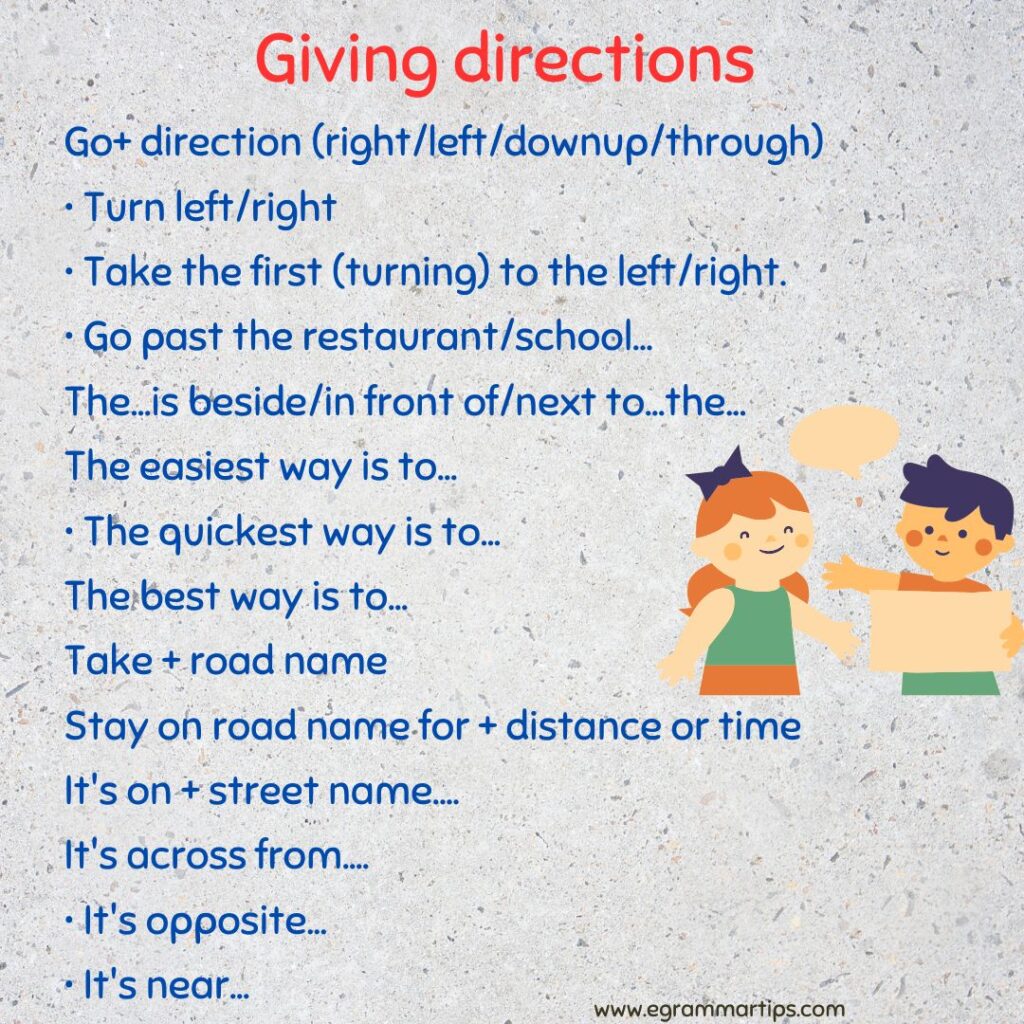
Being able to ask for and give directions is an essential skill in any language, especially English. Whether you’re a traveler navigating a new city or simply helping someone find their way, knowing the right phrases can make all the difference.
1. Introduction to Asking and Giving Directions
Understanding and using phrases for asking and giving directions is crucial in everyday communication. Whether you’re in a bustling city, a small town, or even within a large building, these phrases help you navigate effectively and assist others. Mastering these phrases ensures you can handle various situations, from asking a stranger for directions to guiding someone to their destination.


2. Basic Vocabulary for Directions
Before diving into specific phrases, it’s important to know the basic vocabulary:
•Directional Words:
Left, right, straight, forward, backward
•Cardinal Directions: North, south, east, west
•Location Descriptors: Next to, opposite, across from, in front of, behind, between
These words form the foundation of most direction-giving phrases and are essential for clarity.
3. Common Phrases for Asking Directions
When asking for directions, it’s important to be polite and clear. Here are some useful phrases:
•Polite Openings:
° “Excuse me, could you tell me how to get to…?”
° “Pardon me, do you know where the nearest… is?”
° “Could you please give me directions to…?”
•Direct Questions:
° “How do I get to the bus station?”
° “Where is the closest pharmacy?”
° “What’s the best way to get to the city center?”
•Clarification Requests:
° “Can you show me on the map?”
° “Is it far from here?”
° “Could you repeat that, please?”
These phrases help you initiate the conversation in a respectful and effective manner.
4. Common Phrases for Giving Directions
When someone asks you for directions, you can use these phrases to guide them:
•Simple Directions:
° “Go straight ahead.”
° “Turn left at the next traffic light.”
° “It’s right around the corner.”
•Detailed Directions:
° “After the bridge, take a right at the first street.”
° “You’ll see a big sign on your left, it’s just past that.”
° “Keep going straight until you reach the roundabout, then take the second exit.”
•Helpful Additions:
° “It’s about a 10-minute walk from here.”
° “You’ll find it next to the large shopping mall.”
° “If you see the library, you’ve gone too far.”
Providing clear, step-by-step instructions ensures the person will easily find their destination.
5. Politeness in Asking Directions
Politeness is key when asking for directions, especially in cultures where directness may be seen as rude. Here are some ways to be polite:
•Softening Requests:
° “Would you mind telling me how to get to…?”
° “Could I trouble you for directions to…?”
° “If it’s not too much trouble, could you help me find…?
•”Using Titles and Names:
° “Excuse me, sir/madam, could you direct me to…?”
° “Pardon me, officer, can you tell me where… is?”
Being polite not only makes the interaction smoother but also increases the likelihood of getting detailed directions.
6. Politeness in Giving Directions
When giving directions, it’s also important to be polite and considerate:
•Offering Help:
° “I’d be happy to help. Where do you need to go?”
° “Sure, let me give you some directions.”
° “Of course, here’s how you can get there.”
•Suggesting Alternatives:
° “If you prefer, you could also take the bus. It’s faster.”
° “There’s another way, but it’s a bit longer.”
•Ending the Conversation:
° “I hope that helps! Have a great day.”
° “Let me know if you need any more help.”
° “Good luck, and enjoy your visit!”
Being polite and offering additional help when needed shows kindness and helps the person feel more comfortable.
7. Asking for Directions in Different Settings
Different settings require slightly different phrases:
•On the Street:
° “Excuse me, where is the nearest subway station?”
“Can you tell me how to get to the central park?”
•In a Building:
° “How do I get to room 305?”
° “Which floor is the cafeteria on?”
•Using Public Transport:
° “Which bus goes to the main square?”
° “Is this the right train for downtown?
Tailoring your question to the setting ensures clarity and relevance.
8. Giving Directions in Different Contexts
The context in which you give directions can also change the way you phrase them:
•Walking Directions:
° “It’s a five-minute walk from here. Just head straight and then turn left at the bakery.”
° “Walk down this street until you see the park, then take a right.”
•Driving Directions:
° “Take the highway and exit at junction 14, then follow the signs for the airport.”
° “Turn left at the next traffic light, and after about 2 kilometers, you’ll see the hotel on your right.”
• Navigating Within a Building:
° “Take the elevator to the third floor, and then turn right. The conference room will be the second door on your left.”
° “Go down this hallway until you reach the reception desk, then take a left to find the restroom.”
Each context may require slightly different vocabulary and instructions, but the key is to provide clear, actionable directions.
9. Clarifying Directions
Sometimes, after receiving directions, you might need further clarification to ensure you understood correctly:
•Asking for Repetition:
° “Could you say that again, please?”
° “I’m sorry, can you repeat the last part?”
•Confirming Understanding:
° “So, I turn left after the bank, right?”
° “Just to confirm, I take the second right after the park?”
• Asking for More Details:
° “Is it close to the big park?”
° “Is there a sign I should look out for?”
These phrases help ensure that both you and the person giving directions are on the same page, reducing the chance of getting lost.
10. Expressing Confusion or Uncertainty
Sometimes, you might not be sure about the directions you’re given, or you may not know how to give directions yourself. Here’s how you can express that:
•Phrases for When You’re Unsure:
° “I’m not entirely sure, but I think it’s this way.”
° “I believe it’s near the big supermarket, but I’m not certain.”
• Asking Someone Else:
° “Let me check with someone else to be sure.”
° “I’ll ask someone nearby to confirm.”
• Politely Declining to Give Directions:
° “I’m sorry, I’m not familiar with this area.”
° “I wish I could help, but I’m not sure where that is.”
Expressing uncertainty honestly can prevent miscommunication and help direct the person to someone who might know better.
11. Using Technology to Ask and Give Directions
In today’s digital age, technology can greatly aid in giving and receiving directions:
• Asking for Directions via Apps:
° “Could you input this address in Google Maps?”
° “Do you have access to a navigation app like Waze or Maps?”
•Using Navigation Apps to Give Directions:
° “You can just follow the route on your GPS; it will guide you step by step.”
° “If you use Google Maps, it will show you the fastest route with traffic updates.”
•Mentioning Online Resources:
° “You can also check the route on Waze; it’s quite reliable.”
° “If you’re unsure, try looking it up on Google Maps.”
Leveraging technology ensures that directions are accurate and can even provide real-time updates, which is especially useful in unfamiliar areas.
15. Conclusion: Becoming Proficient in Direction-Related Phrases
Mastering the phrases for asking and giving directions is a crucial part of becoming fluent in English. It not only helps in everyday situations but also boosts your confidence in communicating in a foreign language. Remember to:
•Practice Regularly: Engage in conversations that involve giving or asking for directions to keep your skills sharp.
•Be Polite: Politeness goes a long way in ensuring clear and positive interactions.
•Use Technology: Don’t hesitate to use maps and apps to enhance your ability to give accurate directions.
•Learn From Experience: Each time you ask for or give directions, you’re learning and improving.
By integrating these phrases and tips into your daily practice, you’ll find yourself more capable and comfortable navigating any English-speaking environment.